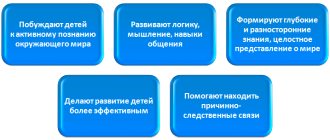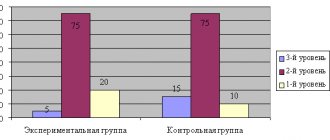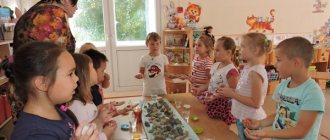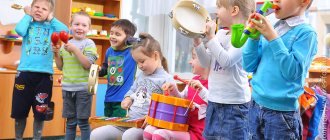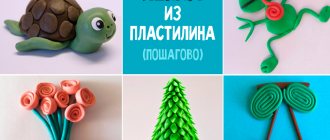Lapbook on the topic: “Pets and birds” for kindergarten with your own hands
Lapbook on the topic: “Pets and poultry” for preschool children
Author: Olga Nikolaevna Ryazanova, teacher Description of work: this material will be useful for educators, parents and people who want to try something new with their children. Purpose: The lapbook is intended to familiarize and expand children's knowledge about domestic animals. In this manual, you can collect and expand material, create new sections, and insert children’s creative works. Goal: making a lapbook on the topic of pets. Tasks: • select material for the topic; • produce printed board games; • create a laptop; • develop interest in this type of work.
We will need: • ring binder; • colored paper; • glue, brush, scissors; • plastic envelopes; • Double-sided tape; • Internet resources.
Completing the work: 1. I took a ring binder as a basis. I covered the front of the folder and the end with colored paper and wrote an inscription. 2. I prepared bookmarks with various headings: • interesting facts; • verbal and didactic games; • puzzles; • literary works; • Proverbs and sayings. The content can always be replenished and new sections can be introduced.
3. I found the necessary material for each section on the Internet.
For colorfulness and accessibility, on the first page, I inserted a picture with this pet (bird). Each section was designated by a “separator.” 4. I laminated the printed board games and put them in plastic envelopes, which I then attached with double-sided tape to the walls of the folder. Since there could be a lot of games, some of them were inserted into the files in the section “Verbal and didactic games”
. All games are laminated, so they will last a long time. And when children learn to read, they will be able to use the works included in the corresponding section themselves.
Section contents:
Interesting Facts
Camel A tired camel wanders through the desert.
He wants water, but he can’t find it. As the sun is blazing, there is not a cloud in the sky. And underfoot there is sand and thorns. Camels played a significant role in the life of the nomadic peoples of the East.
They were used as pack, draft and riding animals. Nomads found their way in the sands only thanks to the instinct of camels. It happened that nomads satisfied their severe hunger by cutting pieces of fat from the humps of camels. But upon the caravan’s arrival at its destination, the camel drivers gave the camels a royal rest. They gave them plenty of food and drink, and treated them to tobacco and tea leaves. Camels bring great benefits to people. It is customary to eat camel meat; cheese and butter are made from camel milk; make fabrics from wool. Even droppings were used as fuel. The Arabs call camels “ships of the desert.” Indeed, camels are capable of walking 100 km a day, carrying luggage weighing 200–300 kg on their backs. The genus of camels includes two species - the two-humped camel, or Bactrian, and the one-humped camel, or dromedary. They were domesticated about 5 thousand years ago. It is believed that there are only about 300 wild Bactrians left. They live in the southwest of Mongolia, in the Gobi Desert. These are large animals, up to 2.5 m high and weighing about 700 kg. The horse is racing across the steppe, give way to it.
And the camel thought: “I won’t gallop after her.” Yu. Parfenov Bactrian camels are perfectly adapted to living in desert areas.
They have excellent vision. Visual memory helps to navigate in the desert, a keen sense of smell helps to sense water several tens of kilometers away. Camels feed mainly on tough shoots of saxaul and camel thorn. Camels live 35–40 years; once every two years, the female gives birth to one calf. The dromedary camel is slightly smaller than the Bactrian camel, but has longer and slimmer legs. The camel can be called “the most economical animal.” His body is ideally adapted to retain moisture in hot desert conditions. A camel's body temperature ranges from 34 degrees at night to 40 degrees during the day. At the same time, the camel hardly sweats. Carefully using the moisture contained in the body, a camel, when it gets to a source of water, is able to drink a truly colossal amount of liquid. The “world record” belongs to a camel, which in one sitting absorbed 94 liters of water, and after some time drank another 186 liters. Interesting facts about the goat
1. Goats often chew seemingly inedible objects.
This is not because they are supposedly stupid, but simply because of their natural curiosity - they are interested in tasting everything. 2. One goat can have a herd of 40-50 goats, which he will lead. 3. All currently existing breeds of these animals descended from the wild bezoar goat. This animal is still found in the wild. 4. Goats were one of the first animals domesticated by humans. This happened around the 7th millennium BC. 5. Goats have almost 300 degrees of vision. Their eyes are generally unique, with horizontal rectangular pupils. 6. Goats have almost 300 degrees of vision. Their eyes are generally unique, with horizontal rectangular pupils. 7. According to official statistics, the United States occupies the first place in the world in raising goats. 8. In Morocco, due to a lack of grass, goats climb trees and graze there in whole herds, feasting on the fruits of the argan tree, the nuts of which are used to make fragrant oil. 9. Every year, in the first half of April, goat races are held on the island of Tobago in the state of Trinidad and Tobago, attracting many tourists. This sport has existed since 1925. 10. In Scandinavia, from ancient times to this day, sometimes a head of garlic is hung on the neck of goats to protect them from trolls. 11. In the film “Mom” based on the fairy tale “The Wolf and the Seven Little Goats” there are only five kids. When filming this Soviet-Romanian-French musical film, the arithmetic average was chosen, since the fairy tale “The Wolf and the Seven Little Goats” is known in Romania as “The Goat and the Three Little Goats.” 12. Goats are born with teeth. They have no teeth in the upper jaw. Instead, the hard dental cushion acts like teeth. 13. They have excellent memory: they learn very quickly and have long-term memory. Responsive and able to solve simple logic problems. Puzzles
Goat
Not a cow, but with horns: “Who am I?” – find out for yourself. I also chew grass, I also give milk, I wake up early in the morning, I go to the meadow, I graze there until the evening, Well, what’s my name? *** It gives us milk, although it is not a cow, it is ready to share its wool. She is fidgety and fidgety... What do we call her? … *** Loves to chew grass, maybe give him milk. I even visited a fairy tale and saved my children there. She has horns, she’s always slim - This is our dereza! Answer quickly, what kind of name was given to her? *** Loves to chew grass, maybe give milk. I even visited a fairy tale and saved my children there. She has horns, she’s always slim - This is our dereza! Answer quickly, what kind of name was given to her? And so I select riddles for each pet and bird. If there are, then about each “family member” (rooster, hen, chick; ram, ewe, lamb, etc.). Each page with riddles is accompanied by pictures of a given animal (bird).
List of literature about pets and birds
Pets A. Vvedensky “About the girl Masha, about the dog Cockerel and about the cat Thread” (chapters) V. Dmitriev “Baby and the Bug” (chapters) V. Oseeva “Why” V. Suteev “Who did you say meow? G. Garin - Mikhailovsky “Theme and the Bug” D. R. Kipling “The Cat Walking by itself” E. Charushin “Rabbit”, “Cat” K. Paustovsky “Cat - a Thief” K. Ushinsky “Carrying Cow”, “ Blind Horse" L. N. Tolstoy "Kitten", "Fire Dogs", "Lion and Dog" N. Nosov "Living Hat" S. Marshak "The Tale of a Stupid Mouse", "Mustachioed - Striped" S. Mikhalkov "Puppy" , “Kittens” E. Uspensky “Uncle Fyodor, the Dog and the Cat” Russian folk tales “The Wolf and the Seven Little Goats”, “Sivka the Burka”, “The Fox and the Goat”, “The Cockerel and the Bean Seed” (arranged by O. Kapitsa) “The Three Little Pigs” (translated by S. Mikhalkov) Agnia Barto and Pavel Barto “Whoever reads a book can count to ten” Agnia Barto and Pavel Barto “Do Animals Think” V. Zlotnikov “Jack and I” G. Ball “Early in the Morning” Z .N.Aleksandrova “Kitten” Z. Byadulya “Funny joke about the Duck” translation from Bel. E. Axelrod Y. Akim “Little Fox” V.V. Arbekov “Pie” E. Charushin “What kind of animal?” G. Oster “A Kitten Named Woof.” L.N. Tolstoy “The Lion and the Dog”, “Kitten”. Br. Grimm "The Town Musicians of Bremen". R.s.s. "The wolf and the seven Young goats". Poultry B. Zhitkov “The Brave Duckling” G.-H.
Andersen “The Ugly Duckling” M. Prishvin “Guys and Ducklings” N. Emelyanova “Oksya the Hard Worker” O. Donchenko “Petrus and the Golden Egg” E. Blyton “The Famous Tim Duckling” (chapters) in trans. from English E. Papernoy Russian folk tale “Cockerel” Ukrainian folk tale “Spikelet” Proverbs and sayings
Cat • A kind word is also pleasant for a cat.
• Where there is no cat, there is a mouse frolicking. • If you feel sorry for milk, you won't see the cat. • The cat knows whose meat it has eaten. • The little bird started singing early, as if the cat wouldn’t eat it. • Sly as a cat. • The cat also loves the mouse. • The cat loves fish, but doesn’t want to go into the water. • Don't play with coal, your cat will burn its paw. • Throws a cat in the eye. • The cat will shed the tears of a mouse. Verbal and didactic games
(topic dictionary) Nouns:
animals, cow, calf, horse, foal, pig, piglet, cat, kitten, dog, puppy, goat, kid, sheep, lamb, rabbit, baby rabbit, wool, horns, hooves, muzzle, tail, paws, cowshed, stable, pigsty.
Verbs:
runs, butts, gets sick, bites, eats, walks, caresses, barks, grunts, moos.
Adjectives:
beautiful, fluffy, curly, angry, lively, horned, white, red, domestic, pink, spotted.
Goal: Clarification, expansion, activation, generalization of children's vocabulary. Objectives: 1. Clarify and expand active and passive vocabulary; practice choosing definitions. 2. Develop the ability to solve riddles. 3. Reinforce general concepts. 4. Develop memory, attention, logical thinking. “Who is the most attentive?” Let's compare a cow and a horse. What does a cow have that a horse doesn't? (Horns, udder). What does a horse have that a cow doesn't? (Mane). What animals have horns? Hooves? Claws? Mustache? Guess which animal I wished for. He has legs, hooves, a mane, a tail (a horse). The horse neighs. He's looking for…. This animal has legs, hooves, a tail, and horns. This…. What does a cow call her baby? This animal has legs, hooves, a tail, horns, and fur. This is..... “Whose? Whose? Whose? Whose?" Objectives: 1. develop the ability to form possessive adjectives; 2. consolidate children’s knowledge about domestic animals and poultry; 3. develop attention, visual memory; 4. develop the grammatical structure of speech. Based on the picture, children are asked the question: Whose paw is this? (this is a cat's paw). Whose ears are these? (cat's ears). Whose ear: (dog ear) “Semantic series” Instructions: I will name three words, guess what the fourth will be. 1. bird-nest, dog -…; 2. jacket-fabric, boots-...; 3. horse-foal, cow-...; 4. book cover, house -…; 5. dog - puppy, person -... “Who has whom?” Purpose: using the genitive case of singular and plural nouns. The cat has ... (kitten, kittens). The camel has ... (calf, camels). “Pick up a word” Purpose: to teach children to select and name feature words, action words. Ram (what) ... (horned, bold, curly). Rabbit (what) ... (long-eared, cowardly, timid). The dog (what does it do) ... (howls, runs away, chases, barks). “Name the family” Purpose: to introduce children to the names of domestic animals and birds, their families; develop children's speech. Dad is a bull, mom is ... (cow, baby - ... (calf). “Who is the odd one out?” Objectives: 1. to promote the formation of children’s ideas about domestic animals and birds; 2. to develop the ability to classify, draw conclusions; 3. to develop attention, visual memory; 4. consolidate the general concepts of “pets” and “poultry.” “Fun Counting” Objectives: 1. consolidate knowledge of animals; 2. develop the grammatical structure of speech, learn to coordinate nouns with numerals; 3. develop attention, visual memory. The number of games is constantly growing. "The Fourth Wheel"
“Who eats what?” I cut the pictures, laminated them and use them for other board and printed games. “Gather a Family” These pictures can also be used for other games.
"Scheme - description"
When describing animals and birds, I use cards from games. The children began to make a new section with riddles, using work done in class using non-traditional techniques.
This type of visualization is very interesting for children. All games are laminated, so they will last a long time. This is the laptop I made.
Download Lapbook on the topic: “Pets and poultry” for preschool children
We recommend watching:
Lapbook for kindergarten: Trees on our site: Cherry Lapbook for preschoolers with your own hands Lapbook “Space” for the preparatory group of kindergarten Summary of a lesson on speech development “In the world of animals of hot countries” in the preparatory group (for weak
Similar articles:
A story about the platypus for 1st grade children
A story about a hamster for children of senior preschool age
A story about a crocodile for children in kindergarten
Master Class. Lapbook technology and its practical application in teaching materials
Slide 1 New teaching aids that meet the requirements of the Federal State Educational Standard for Education
Lapbook technology and its practical application in teaching
Evdotyeva N.S., teacher, MBDOU kindergarten “Solnyshko” p. New
Goal: increasing the professional competence of teachers in the field of supporting children's initiative and developing the cognitive abilities of preschoolers based on the use of lapbooks.
Tasks:
- introduce teachers to the thematic laptop folder and how to create it;
- consider a lapbook as a way to systematize knowledge;
- create conditions for fruitful communication between master class participants in order to develop the creative thinking of teachers.
Equipment: multimedia equipment, laptop layout, cards, game tasks.
Placement of participants: 1st row is 1st group, 2nd row is 2nd group
Progress of the master class
1.Organizational moment slide 1
Master:
-Hello colleagues!
In the context of the implementation of the Federal State Educational Standard for Education, each teacher is looking for new means and methods that meet the goals and requirements of education.
Help me. What, according to the requirements of the Federal State Educational Standard, should educational activities be in the light of modern requirements. slide 2
The main feature of the organization of educational activities in preschool educational institutions at the present stage is the departure from educational activities (classes), increasing the status of play as the main activity of preschool children; inclusion in the process of effective forms of work with children: ICT, project activities, gaming, problem-based learning situations as part of the integration of educational areas.
Thus, “class” as a specially organized form of educational activity in kindergarten is abolished. The activity should be a specific children's activity that is interesting for children, specially organized by the teacher, implying their activity, business interaction and communication, the accumulation by children of certain information about the world around them, the formation of certain knowledge, skills and abilities.
Answers: interesting, educational, practice-oriented, diverse, developing….
Master: Teachers are constantly searching for new teaching tools and methods. For example, I offer you this guide:
Slide 3
Think about how you can use such a manual in the educational process, 2 minutes for discussion
Answers: Group 1-
Group 2-
Master: Let's combine opinions and draw a conclusion:
Before us is a kind of organizer, a storage folder where you can place educational information, puzzles, coloring pages, pictures. In other words, laptop
2.Deepening understanding of the stated topic
Master: Let's move on to discussing the issue.
Read the definition to clarify your ideas (hand out pieces of paper): slide 4
Food for thought
A laptop is a storage folder, the information in which is presented in the form of opening windows, with leaves that can be removed and unfolded, with pockets, doors, movable parts, and small books that a child can take out, rearrange, and fold at his discretion. It collects material on a specific topic. It would be even more correct to define a lapbook not as a teaching tool, but as a special form of organizing cognitive material.
What questions have arisen? Does everyone understand the purpose of a laptop?
Master: Let's determine the relevance of this manual!
So, lapbook:
-informative;
- multifunctional, i.e. promotes the development of creativity and imagination.
-variable, multifunctional (there are several options for use);
-suitable for use simultaneously by a group of children and in independent activities,
-lapbook – a type of joint activity between an adult and a child;
-its structure and content are accessible to children;
-provides gaming, educational, research and creative activity,
Let me remind you that there are no strict requirements for the form, it all depends on your taste and capabilities. The laptop can be thematic, can be reusable, with replaceable information.
It is clear that in order for the manual to be effective, it must be strong enough, safe, with or without inscriptions, storage pockets can be of any shape, from any material. It is very important to ensure the moment of searching, not just to open the envelope, but first to guess the riddle, etc.
3. Presentation of laptops slide 5
Look at the finished laptops
Do you think the benefit promotes children's cognitive development? slide 6
In the understanding of children, a laptop is a bright, “mysterious” book that contains many secrets and mysteries, which you want to look at and study, return again and again to its contents, encouraging active interaction with adults and peers.
- Practical work in groups:
Now I would like to create, or rather complete the creation of, laptops together with you. For this I will need volunteers from the audience...(call 3 people each) slide 7
Master: Creating a laptop takes place in several stages:
- Defining a theme
- Writing a plan. A laptop is not just a book, but a teaching aid. Therefore, you need to think about what it should include to cover the topic
- creating a layout. Come up with pockets, notebooks, i.e. there is no limit to your imagination slide 8
- making folders and laptop parts
- placing all the parts in their places.
When preparing laptops, do not forget - the majority of children do not know how to read! Try not to post text material.
I suggest you create a laptop. You have some preparations. To begin with, think about how to place pockets and books
As you work, think about what you would add, what you would do maybe differently...
Practical work in groups (3-5 min)
Presentation of laptops (2 min)
Master: What problems arose? What did you notice?
Do you agree that the lapbook is not just a teaching tool, but a form of organizing (organizing) educational material.
Let's discuss another area of using laptops.
Can a laptop be a means of attracting parents to cooperate?
What arguments would you give to attract parents to create laptops?
For example, if you have children who are high school students, you probably know that according to the Federal State Educational Standard, completing an individual final project is mandatory for every student in grades 10 and 11. During one academic year, the student is required to complete one final individual project. This means that we must prepare children in advance for such activities.
Answers:
Master: Consider the following situation: at the beginning of the year, the parents of graduates offered to give something as a gift to the kindergarten for graduation. Your task is to explain to them that a laptop is the best gift, choose a topic that is relevant to you, tell them about the requirements, etc.
For example, Petya’s mother works in a store. What kind of laptop can this family order? (“In the store”, “Profession of a salesperson”, etc.) What will be its content?
Approximate contents of the laptop: slide 9
1. Folding bed “Story about a profession” (for a child to independently compose a story about his profession) 2. Envelope “Workwear” (paper man and clothes for him) 3. Rotating circle “Who works here?” (a game)
4. Accordion book “Guess the profession” (contains riddles) 5. Mini-book “Poems about professions” (contains poems) 6. Mini-book “Coloring” (pictures for the child to color)
7. more options
Reflection on the goals and objectives of the master class
- Let's summarize the work
Does a laptop have practical value?
How difficult is it to create a laptop?
Will you use a similar manual in your work?
-Look at the slide. In preparation for the meeting, I set myself the following goals and objectives. Analyze them. Have we achieved the goals set in our joint activities?
Annex 1
Work plan of the creative group of the preschool educational institution
“Lapbook technology and its practical application in teaching”
Session 1
1.What is a lapbook. Elements of a lapbook (directed by N.S. Evdotyeva)
2. Types of laptops. (headed by N.S. Evdotyeva)
3. Practical work “How to create a folder for a laptop” (supervisor: Evdotyeva N.S.)
Session 2
1. Master class for teachers “Lapbook technology and its practical application in teaching” (led by N.S. Evdotyeva)
Session 3
1.Lapbook as a new way of systematizing knowledge. (headed by N.S. Evdotyeva)
2. Practical work. Filling laptops with a specific focus (supervisor N.S. Evdoteva)
Session 4
1.Lapbook - as a means of developing the cognitive abilities of children of senior preschool age (supervisor N.S. Evdotyeva)
2. Presentation of laptops of various directions (preschool teachers
MAGAZINE Preschooler.RF
Summary of an open event with children 4-5 years old on cognitive development using the lapbook “Visiting the Forester”Goal: to generalize children’s knowledge about living nature, to promote the development of cognitive interests.
Tasks:
Tasks:
1) Developmental
- develop curiosity, memory, ability to draw conclusions
- develop imagination, the ability to fantasize
- develop active speech skills, enrich active vocabulary
- promote the development of cognitive interests
- to introduce an effective relationship with nature.
2) Educational
- develop the ability to solve riddles
- develop the ability to quickly find the correct answer to a question
- develop problem solving skills
- improve the ability to find correspondence between tree species and their leaves
- consolidate children's knowledge about animals and birds, develop the ability to classify them.
3) Educational
- build independence
- develop the ability to comply with the rules of behavior in nature
- continue to cultivate a love for nature and respect for it.
Integration of educational areas: social and communicative development, speech development, artistic and aesthetic development, cognitive development, physical development.
Methods and materials: gaming, practical, verbal
Individual work: activating inactive children
Materials and equipment: Laptop, flash card with a recording of a video message from the forester, a parcel, pages of the lapbook “On a visit to the forester” , cut out of colored paper “Puddles” , recordings of bird voices, the sound of the forest, magical music, tree decorations (birch, oak, fir tree ), forester's house; 2 garbage bags - yellow and blue; garbage - paper and plastic, a jar of honey.
Progress of the lesson:
B. Come in, come in, I’m very glad to see you. An interesting journey awaits us now.
Come closer and show me your eyes.
(Children stand in a circle)
— Guys, look how many guests have come to you. Let's greet them, smile and show our good mood.
We will all hold hands and smile at each other. On the right is a friend and on the left is a friend, Let's smile to everyone around!
Amazing! Your smiles made the room brighter.
– I really want to meet you. Let's pass the ball to each other and say our name. I am Valentina Alekseevna.
I almost forgot, the postman met me on the street and handed me this parcel. He asked me to give the shuttle to the kindergarten children. But I don’t know if I got there? (children's answers)
Guys, are you wondering what's inside? Let's open it and take a look.
The teacher with the children opens the package, and there is a laptop and a flash card. The teacher takes out the contents of the package. Guys, we have a laptop, a flash card, let's see what they sent.
Watching the video message.
"Hello children. I got into trouble! The wind blew the pages of my magic book through the forest, but I can’t collect them because I have a high fever. Help me please! So that you don’t get bored on the way, my friends, the forest dwellers, have prepared many interesting tasks for you. See you soon. Lesovichok."
Educator: And what to do now, because L. is sick?
Children: Take your medicine! Let's go to the aid of Lesovich
Educator: You know, for a patient a kind word and friendly support help as much as medicine!
Q. Guys, before you go into the forest, you need to prepare. Let's review the rules of conduct in the forest. I will tell you actions, and you respond. If the action is good, we say “YES” , if it is bad, then “NO” .
-If you come to the woods and pick a daisy (Answer: no.) -If you eat a pie and throw away the piece of paper (Answer: no.)
-If you leave a piece of bread on a stump (Answer: yes.) -If you tie a branch with a peg (Answer: yes.)
-If you make a fire and don’t put it out (Answer: no.) -If you make a big mess and forget to clean it up (Answer: no.)
If you come into the woods, will you scare everyone away? (no) -If you remove the garbage and bury the jar (Answer: yes.) -If you love your nature
and help her (Answer: yes.)
V. What great fellows. You know all the rules of behavior. To find ourselves in the forest we need to cast a magic spell. (magical music sounds)
We need to close our eyes, take two big jumps, stretch our arms forward, and then vice versa.
Like leaves, spin around. So that we can find ourselves in the forest. Here's a miracle of miracles: We found ourselves in the forest!
(An audio recording of bird voices sounds.)
IN.
Guys, look what kind of tree this is with different leaves. Does this happen in nature? Here lies the mystery. What is this strange leaf? (this is a page from the forest boy’s magic book) Guys, let’s sit under the Christmas tree and play a game: which tree is the leaf from?
V. Well done, guys, you know the trees of our forest well, and we will move on.
We move on again - Is there a body of water in front of us? We already know how to jump, we will jump more boldly
One-two, now the water is behind.
Educator: Guys, who is that knocking in the forest? (woodpecker) And here he is sitting on a tree. Do you recognize other birds by their voice? Listen and guess.
(voices of birds).
What are the birds that fly south in the fall called? migratory
What about those who stay for the winter? wintering.
Guys, look, here’s another leaf from the forester’s magic book. You need to place wintering and migratory birds in different pockets on the page.) Which bird do you like best?
Educator: Well done guys, and you know the birds. Let us play the game “Birds”
Come on, the birds flew, They flew and sat down, They pecked the grains, They drank some water.
They washed the feathers, looked to the sides, and flew to the clearing.
Educator: Guys, who is that sitting under the birch tree and puffing? (hedgehog)
Educator: Oh, what’s that on the hedgehog’s pins (leaf from the book) And here they solved the riddles. Let's sit down in the clearing and guess all the riddles (the children on the page make up the animal)
V. Well done and you completed this task. And we need to move on.
Along the path, along the path We gallop on the right leg (Jump on the right leg.) And along the same path We gallop on the left leg. (Jump on your left leg.)
Let's run along the path and reach the lawn. (Running in place.)
Q. Guys, look at what a beautiful house. Who lives in it? (children's answers
)A forest boy comes out of the house.
Lesovichok. Hello guys. Finally you came to me.
Q. Hello. How is your health? L Thank you, I feel better now. Q But why is there so much garbage here? L. Once upon a time there was a beautiful clearing here, but some people came, rested here, and left their garbage. I don't know what to do now?
Q. Guys, what do you think should be done? (children's answers)
L. That’s right, we will collect the garbage in different garbage bags: paper in yellow, and plastic in blue. (children complete the task)
Q. Well done, they collected all the garbage! And we also found several pages of your magic book. Here you go, you just didn’t find the last page.
Lesovichok. And I found it among the garbage. Now I'll glue the book together. Thank you guys for your help. And for this I want to treat you with honey. Eat to your health and remember me.
V. Thank you, forest guy. It's time for us to go back to kindergarten. And don't forget to take your trash with you. (Children say goodbye to the forester.) Guys, let's cast a spell:
We need to close our eyes, take two big jumps, stretch our arms forward, and then vice versa.
Like leaves, spin around. So that we can find ourselves in the garden. Here's a miracle of miracles: We ended up in kindergarten!
Q. Guys, let’s take a break from the path and sit down on the chairs.
Reflection.
- Did you guys like our trip?
- What was interesting?
- Who did you meet along the way?
Q. I want to thank you very much, you completed all the tasks, I really enjoyed working with you. Goodbye.
| Next > |
